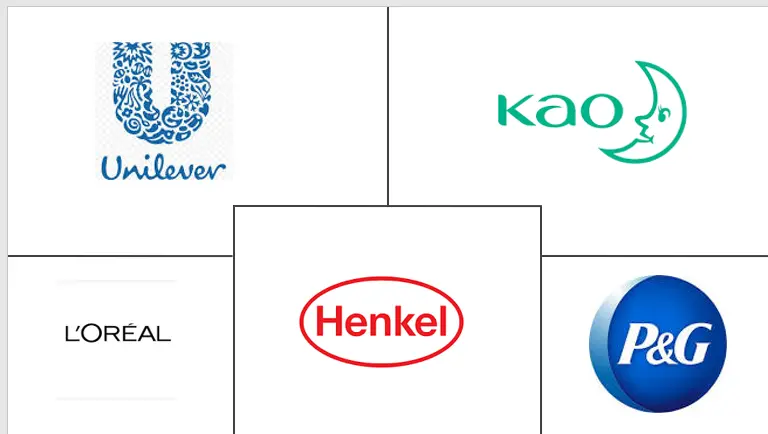Market Size of Middle East & Africa Hair Conditioner Industry

| Study Period | 2019 - 2029 |
| Base Year For Estimation | 2023 |
| Forecast Data Period | 2024 - 2029 |
| Historical Data Period | 2019 - 2022 |
| CAGR | 3.33 % |
| Market Concentration | Low |
Major Players
*Disclaimer: Major Players sorted in no particular order |
MEA Hair Conditioner Market Analysis
Middle East & Africa Hair Conditioner market is projected to grow at a CAGR of 3.33% during the forecast period 2020 - 2025.
- Demand for hair care products will remain as consumers are increasingly focusing on upgrading to higher quality products, to maintain the health of their hair. This is expected to lead to global products being launched in the local market.
- The demand from consumers for hair care products is high because the tap water in the UAE is hard and carries lots of chlorine, which can cause hair to weaken and lead to hair fall. Furthermore, constant exposure to the sun may also cause severe hair problems such as hair fall, which further emphasizes the importance of hair conditioning products.
MEA Hair Conditioner Industry Segmentation
Middle East & Africa Hair Conditioner market by product type, distribution channel, and geography. On the basis of product type, the market is segmented into Intensive Hair Conditioner, Traditional Hair Conditioner, Other Hair Conditioner. On the basis of the distribution channels, the market is segmented into Supermarkets/Hypermarkets, Specialty Stores, E-Commerce, Pharmacies/Drugstore, Other Distribution Channels. On the basis of geography, the report provides a regional analysis, which includes UAE, Saudi Arabia, South Africa, and the Rest of Middle East & Africa.
| By Product Type | |
| Intensive Hair Conditioner | |
| Traditional Hair Conditioner | |
| Other Hair Conditioner |
| By Distribution Channel | |
| Supermarkets/Hypermarkets | |
| Speciality Stores | |
| E-Commerce | |
| Pharmacies/Drugstore | |
| Other Distribution Channels |
| Geography | |
| United Arab Emirates | |
| Saudi Arabia | |
| South Africa | |
| Rest of Middle East & Africa |
Middle East & Africa Hair Conditioner Market Size Summary
The Middle East & Africa hair conditioner market is experiencing a steady growth trajectory, driven by an increasing consumer preference for high-quality hair care products. This trend is largely attributed to the harsh environmental conditions in the region, such as hard tap water and high sun exposure, which necessitate the use of conditioning products to maintain hair health. The market is witnessing a surge in the availability of global brands, with premium hair care companies like Aveda and Balmain establishing a presence in the region. Consumers, including expatriates, are showing a strong inclination towards premium and natural hair care products, motivated by the benefits these products offer and a growing awareness of the adverse effects of chemical ingredients.
The rise of e-commerce is significantly influencing the hair conditioner market in the Middle East & Africa, with consumers increasingly turning to online platforms for their purchases. The acquisition of Souq.com by Amazon and the launch of Noon.com by Mohamed Alabbar are pivotal developments that have enhanced the accessibility and variety of hair care products available to consumers. The market is highly competitive, dominated by multinational brands such as Procter & Gamble, L'Oreal, Johnson & Johnson, and Unilever, while domestic brands are gaining traction in the botanical and natural product segments. Companies are focusing on product innovation and the incorporation of active ingredients to maintain their competitive edge in this dynamic market landscape.
Middle East & Africa Hair Conditioner Market Size - Table of Contents
-
1. MARKET DYNAMICS
-
1.1 Market Drivers
-
1.2 Market Restraints
-
1.3 Porter's Five Forces Analysis
-
1.3.1 Threat of New Entrants
-
1.3.2 Bargaining Power of Buyers/Consumers
-
1.3.3 Bargaining Power of Suppliers
-
1.3.4 Threat of Substitute Products
-
1.3.5 Intensity of Competitive Rivalry
-
-
-
2. MARKET SEGMENTATION
-
2.1 By Product Type
-
2.1.1 Intensive Hair Conditioner
-
2.1.2 Traditional Hair Conditioner
-
2.1.3 Other Hair Conditioner
-
-
2.2 By Distribution Channel
-
2.2.1 Supermarkets/Hypermarkets
-
2.2.2 Speciality Stores
-
2.2.3 E-Commerce
-
2.2.4 Pharmacies/Drugstore
-
2.2.5 Other Distribution Channels
-
-
2.3 Geography
-
2.3.1 United Arab Emirates
-
2.3.2 Saudi Arabia
-
2.3.3 South Africa
-
2.3.4 Rest of Middle East & Africa
-
-
Middle East & Africa Hair Conditioner Market Size FAQs
What is the current Middle East & Africa Hair Conditioner Market size?
The Middle East & Africa Hair Conditioner Market is projected to register a CAGR of 3.33% during the forecast period (2024-2029)
Who are the key players in Middle East & Africa Hair Conditioner Market?
Procter & Gamble Co., L'Oreal S.A., Johnson & Johnson Consumer Inc., Unilever and Amway are the major companies operating in the Middle East & Africa Hair Conditioner Market.

